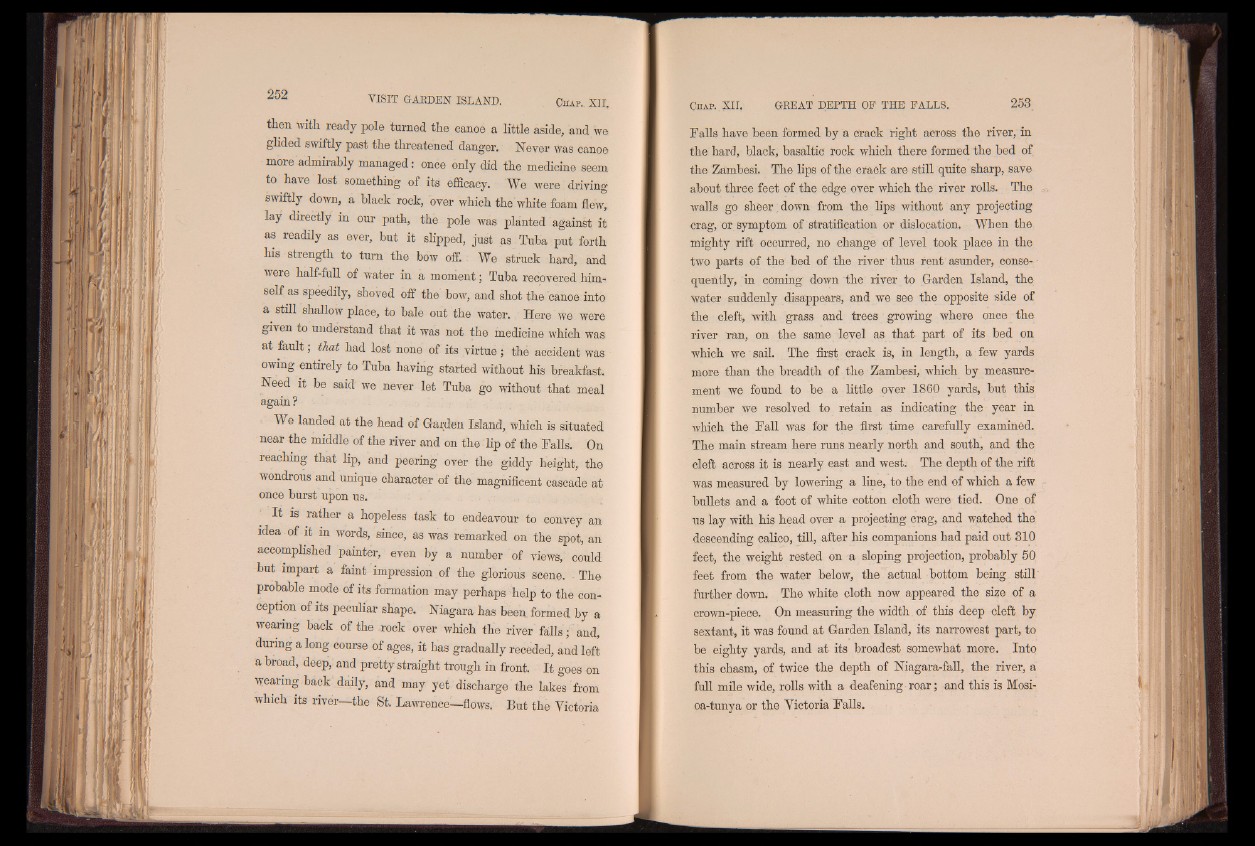
then with ready pole turned the canoe a little aside, and we
glided swiftly past the threatened danger. Never was canoe
more admirably managed: once only did the medicine seem
to have lost something of its efficacy. We were driving
swiftly down, a black rock, over which the white foam flew,
lay directly in our path, the pole was planted against it
as readily as ever, but it slipped, just as Tuba put forth
his strength to turn the bow off. We struck hard, and
were half-full of water in a moment ; Tuba recovered himself
as speedily, shoved off the bow, and shot the canoe into
a still shallow place, to bale out the water. Here we were
given to understand that it was not the medicine which was
at fault ; that had lost none of its virtue ; thé accident was
owing entirely to Tuba having started without his breakfast.
Need it be said we never let Tuba go without that meal
again?
We landed at the head of Garden Island, which is situated
near the middle of the river and on the lip of the Falls. On
reaching that lip, and peering over the giddy height, the
wondrous and unique character of the magnificent cascade at
once burst upon us.
I t is rather a hopeless task to endeavour to convey an
idea of it m words, since, as was remarked on the spot, an
accomplished painter, even by a number of views, could
but impart a faint impression of the glorious scene. The
probable mode of its formation may perhaps help to the conception
of its peculiar shape. Niagara has been, formed by a
wearing back of the rock over which the river falls; and,
during a long course of ages, it has gradually receded, and left
a broad, deep, and pretty straight trough in front. I t goes on
wearing back daily, and may yet discharge the lakes from
which its river—the St. Lawrence—flows. But the Victoria
Falls have been formed by a crack right across the river, in
the hard, black, basaltic rock which there formed the bed of
the Zambesi. The lips of the crack are still quite sharp, save
about three feet of the edge over which the river rolls. The
walls go sheer. down from the lips without any projecting
crag, or symptom of stratification or dislocation. When the
mighty rift occurred, no change of level took place in the
two parts of the bed of the river thus rent asunder, consequently/
in coming down the river to Garden Island, the
water suddenly disappears, and we see the opposite side of
the cleft, with grass and trees growing where once the
river ran, on the same level as that part of its bed on
which we sail. The first crack is, in length, a few yards
more than the breadth of the Zambesi, which by measurement
we found to be a little over 1860 yards, but this
number we resolved to retain as indicating the year in
which the Fall was for the first time carefully examined.
The main stream here runs nearly north and south, and the
cleft across it is nearly east and west. The depth of the rift
was measured by lowering a line, to the end of which a few
bullets and a foot of white cotton cloth were tied. One of
us lay with his head over a projecting crag, and watched the
descending calico, till, after his companions had paid out 310
feet, the weight rested on a sloping projection, probably 50
feet from the water below, the actual bottom being still'
further down. The white cloth now appeared the size of a
crown-piece. On measuring the width of this deep cleft by
sextant, it was found at Garden Island, its narrowest part, to
be eighty yards, and at its broadest somewhat more. Into
this chasm, of twice the depth of Niagara-fall, the river, a
full mile wide, rolls with a deafening roar; and this is Mosi-
oa-tunya or the Victoria Falls.